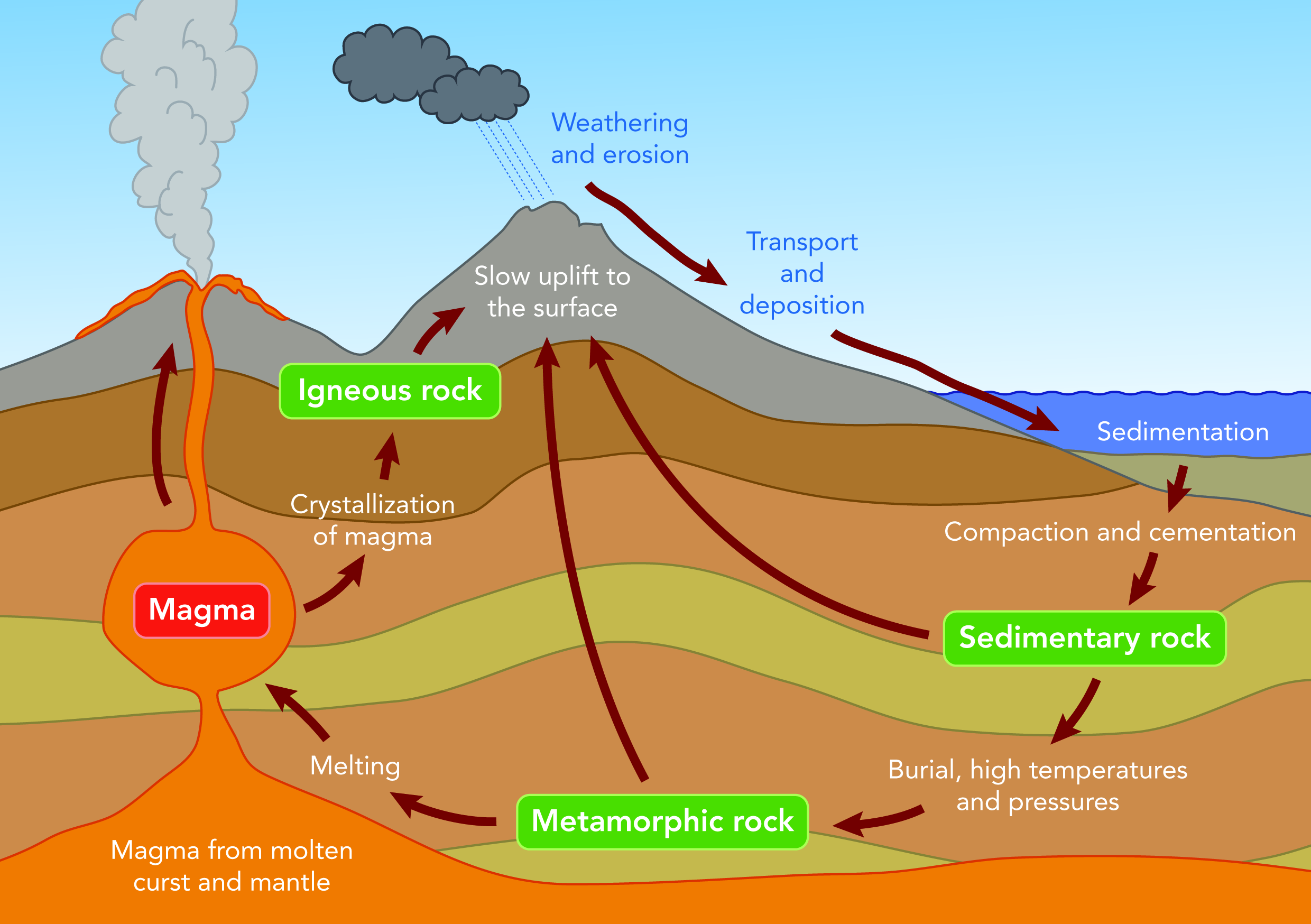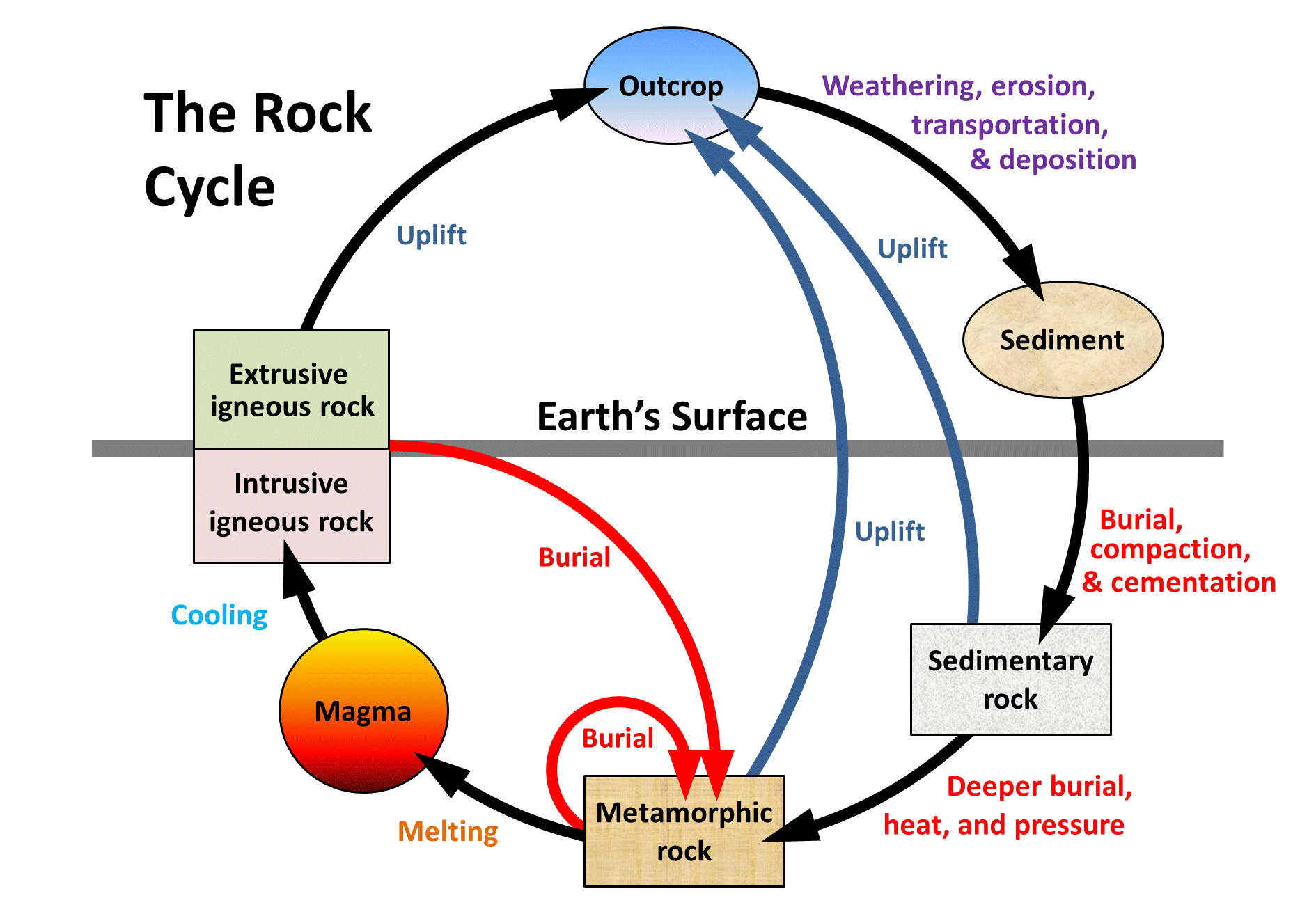The Rock Cycle Describes Geologic Processes in Which
Sedimentary rocks are formed from pieces of other existing rock or organic material. The rock cycle is a concept used to explain how the three basic rock types are related and how Earth processes over geologic time change a rock from one type into another.
The Rock Cycle is Earths great recycling process where igneous metamorphic and sedimentary rocks can all be derived from and form one another.

. Intrusive igneous rocks form when magma solidifies. The Geological Cycle of Rock formation Geological cycle includes many processes acting simultaneously. Deposition process in which sediment is laid down in new locations erosion.
Presents the three major rock types and the processes that lead to their formation in the rock cycle. The rock cycle basic definiton is transitions among the three main rock types which are metamorphic igneous and sedimentary rocks. Rock formed from fragments of other rocks or the remains of plants or animals.
Sedimentary metamorphic and igneousEach rock type is altered when it is forced out of its equilibrium conditions. Igneous rock The rock cycle describes the process by which changes occur in the three types of rocks. Metamorphic Rocks changed by intense heat or extreme pressure foliated describes metamorphic rocks whose grains are arranged in parallel layers or bands.
What is the rock cycle. Rock cycle the process by which one rock type changes into another. The Rock Cycle.
The rock cycle represents how rocks may exist through geological time and processes. For example an igneous rock such as basalt may break down and dissolve when exposed to the atmosphere or melt as it is. The Rock Cycle The rock cycle diagram clearly shows all the steps components of the rock cycle including the end results and the movement of the process.
The rock cycle describes the transformation of rock materials from one type to another via various geologic processes. What are the 5 processes of the rock cycle. Each of these rocks are formed by physical changessuch as melting cooling eroding compacting or deformingthat are part of the rock cycle.
This indicates how strong in your memory this concept is. Sediment may accumulate in layers in rivers oceans lakes and valleys creating new rock. The rock cycle is a process in which rocks are continuously transformed between the three rock types igneous sedimentary and metamorphic.
The rock cycle is a concept of geology that describes the transition of rocks between the three rock types. Rocks are classified into three basic types based on how they are formed. Between igneous sedimentary and metamorphic rocks.
The rock cycle is a continuous process describing the transformation of the rocks through various stages throughout their lifetime. Most of us think of rocks as objects which dont change. Changes The rock cycle describes how the three major types of rock--metamorphic igneous and sedimentary--can change into one another through.
The most important of these begin with molten magma from within the earth forming into rock then continue with rocks being broken down into soil and that soil being converted back into rock. All types of rocks change from one type to another over time. The rock cycle is a process in which rocks are continuously transformed between the three rock types igneous sedimentary and metamorphic.
Over time water wind temperature changes and ice may break rock into smaller pieces called sediment. Each of the rocks can be altered when they are force out equilibrium conditionsThe rock cycle describes how the three rock types are interrelated and how processes change from one to another over time. Magma erupts and solidifies on the Earths surface.
Composed of living or once-living material. Analogous to recycling a Coke can where an old can will be used to produce a new can the rock cycle is ever changing the rocks and minerals that make up Earth. Sediment is then transported through erosion and deposited to a new location.
The key processes of the rock cycle are crystallization erosion and sedimentation and metamorphism. The cycle outlines how each rock type can be converted to another rock type through geologic processes. Why is the rock cycle important quizlet.
Processes that explain the relationship between the three rock types. Igneous sedimentary and metamorphic. The rock cycle describes geologic processes in which.
1 The Study Of Minerals 2 Rocks And The Rock Cycle 3 Plate Tectonics 4 Earthquakes And Earths Interior 5 Volcanism And Volcanic Hazards 6 Geologic Maps Block Diagrams And Rock Structures 7 Aerial Photographs Satellite. Rock cycle is the process that completely portrays the complex and interconnected transformation of rock from one category to another. The rock life cycle is a scientific model that shows how rocks can be created changed destroyed and created.
Rocks of any type can be converted into any other type or into another rock of the same type as this diagram illustrates. Sediments are produced when rocks are uplifted weathered and eroded and the resulting detrital material deposited in marine or terrestrial basins. Rocks are constantly being recycled and go through several processes of chemical and physical changes.
Simply put weathering is a process of breaking down rocks into smaller and smaller particles without any transporting agents at play. Steps of the Rock Cycle Weathering. The rock cycle is a basic concept in geology that describes transitions through geologic time among the three main rock types.
Any rock type can become any other. The key processes of the rock cycle are crystallization erosion and sedimentation and metamorphism. Causes Effects and Types of Erosion Water Wind Glacier.
As the magma cools different crystals form at different temperatures undergoing crystallization. Given the rock cycle diagram below match the appropriate geologic process with the corresponding numbered box. There are three main rock types.
Conversion to metamorphic rocks requires conditions of increased. Rock cycle is a basic concept in geology that describes the time-consuming transitions through geologic time. There are three main types of rocks.
The rock cycle simply moves from the igneous to metamorphic to sedimentary rocks and the process repeats itself over and over. Sedimentary igneous and metamorphic. Igneous sedimentary and metamorphic.
Extrusive igneous rocks form when. Crystallization Magma cools either underground or on the surface and hardens into an igneous rock. Plate tectonic activity along with weathering and erosional processes are responsible for the continued recycling of rocks.
It was developed by 18th-century Scottish farmer and naturalist James Hutton according to Visionlearning.



No comments for "The Rock Cycle Describes Geologic Processes in Which"
Post a Comment